Analysis of the 4-v-bind instruction (with code)
The content of this article is about the analysis of the 4-v-bind instruction (with code). It has a good reference value and I hope it can help friends in need.
1. Definition
1.1 The v-bind directive is used to update HTML attributes responsively. In fact, it supports a single JavaScript expression (except v-for).
2. Grammar
2.1 Complete syntax: , explanation: v-bind is an instruction, followed by : The class is a parameter, and classProperty is called the "expected value" in the official documentation.
2.2 Abbreviation syntax: , explanation:: The following class is a parameter, and classProperty is called "expected value" in the official documentation .
3. Usage
3.1 Bind a property
Full code example:
<template><p>
</p>
<p>{{title}}</p>
<span>{{text}}</span></template><script>
export default {
name: "v-bindLearn",
data() { return {
title: "v-bind学习",
first: "span1",
text: "绑定一个属性"
}
}
}</script><style>
.p1{
text-align: left;
}
.spancss1{
float: left;
}</style> Abbreviated code example: 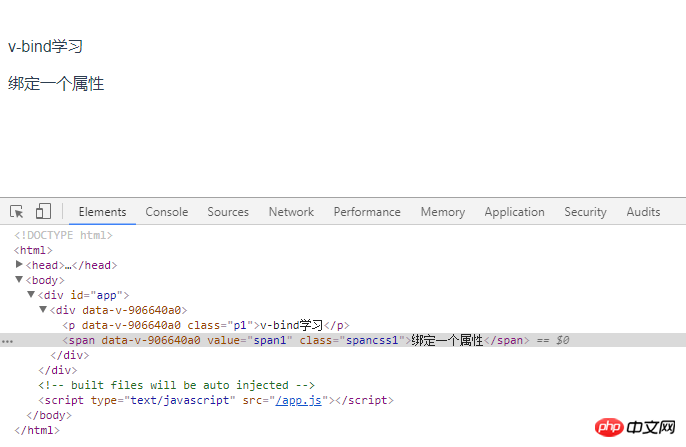
<template>
<div>
<p class="p1">{{title}}</p>
<span :value="first" class="spancss1">{{text}}</span>
</div>
</template>
<script>
export default {
name: "v-bindLearn",
data() {
return {
title: "v-bind学习",
first: "span1",
text: "绑定一个属性"
}
}
}
</script>
<style scoped>
.p1{
text-align: left;
}
.spancss1{
float: left;
}
</style>3.2 Inline string concatenation code example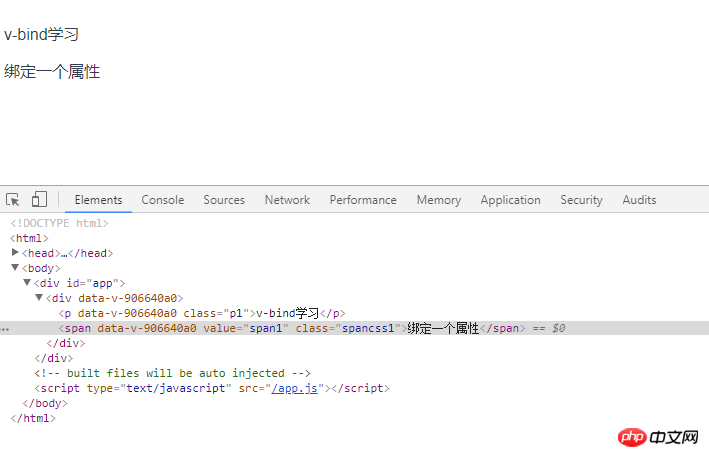
<template>
<div>
<p class="p1">{{title}}</p>
<a :href="'http://'+first" class="spancss1">{{text}}</a>
</div>
</template>
<script>
export default {
name: "v-bindLearn",
data() {
return {
title: "v-bind学习",
first: "www.baidu.com",
text: '点击跳转到百度链接'
}
}
}
</script>
<style scoped>
.p1{
text-align: left;
}
.spancss1{
float: left;
}
</style>3.3 class binding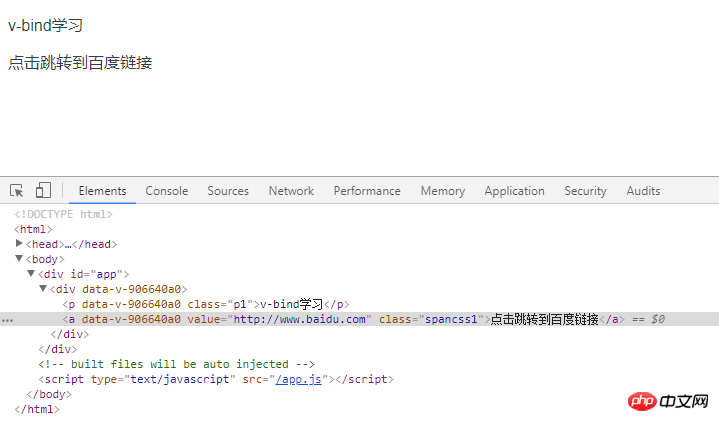
<template>
<div>
<p class="p1">{{title}}</p>
<span v-bind:class="{prop1:isTrue,prop2:isActive}" class="spancss1">{{text}}</span>
</div>
</template>
<script>
export default {
name: "v-bindLearn",
data() {
return {
title: "v-bind学习",
isTrue: false,
isActive: true,
text: "对象语法1"
}
}
}
</script>
<style scoped>
.p1{
text-align: left;
}
.spancss1{
float: left;
}
</style>Method 2 directly declares the object name in the template, declares the attributes prop1 and prop2 in javascript and outputs whether they are available. If the declared attribute value is set to true, the declared attribute value is available. If the declared attribute value is set to false , then the declared attribute value is unavailable, the code is as follows: 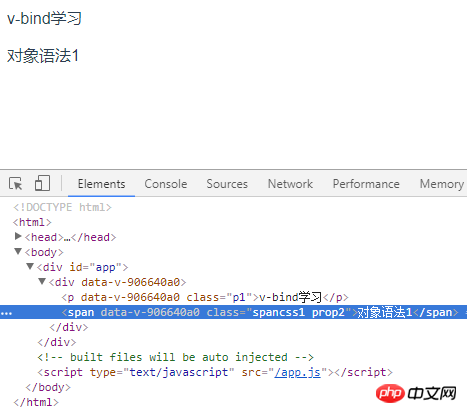
<template>
<div>
<p class="p1">{{title}}</p>
<span v-bind:class="obj" class="spancss1">{{text}}</span>
</div>
</template>
<script>
export default {
name: "v-bindLearn",
data() {
return {
title: "v-bind学习",
obj: {
prop1: true,
prop2: false
},
text: "对象语法2"
}
}
}
</script>
<style scoped>
.p1{
text-align: left;
}
.spancss1{
float: left;
}
</style>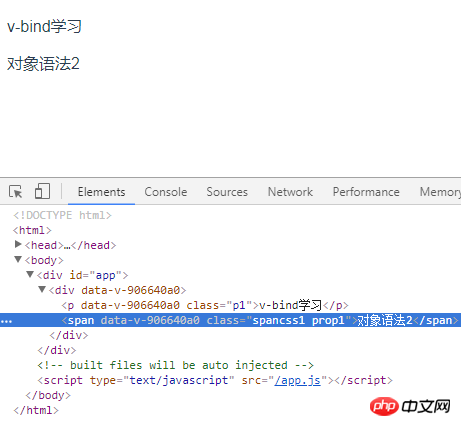 method always declares the array name directly in the template, Output the required array elements in javascript. The sample code is as follows:
method always declares the array name directly in the template, Output the required array elements in javascript. The sample code is as follows:
<template>
<div>
<p class="p1">{{title}}</p>
<span v-bind:class="arr" class="spancss1">{{text}}</span>
</div>
</template>
<script>
export default {
name: "v-bindLearn",
data() {
return {
title: "v-bind学习",
arr: ['prop1','prop2','prop3'],
text: "数组语法1"
}
}
}
</script>
<style scoped>
.p1{
text-align: left;
}
.spancss1{
float: left;
}
</style><template>
<div>
<p class="p1">{{title}}</p>
<span v-bind:class="[prop1,prop2,prop3]" class="spancss1">{{text}}</span>
</div>
</template>
<script>
export default {
name: "v-bindLearn",
data() {
return {
title: "v-bind学习",
prop1: 'prop1',
prop2: false,
prop3: 'prop3',
text: "数组语法2"
}
}
}
</script>
<style scoped>
.p1{
text-align: left;
}
.spancss1{
float: left;
}
</style>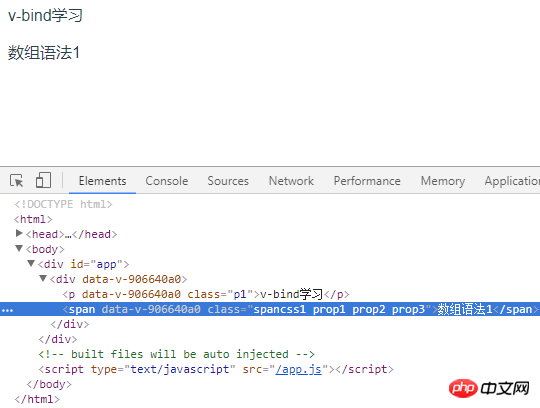 Method three switches the bound class in the list based on conditions, declares the array and conditional expression in the template, and outputs the value of the conditional expression of the array element in JavaScript. The sample code is as follows:
Method three switches the bound class in the list based on conditions, declares the array and conditional expression in the template, and outputs the value of the conditional expression of the array element in JavaScript. The sample code is as follows: <template>
<div>
<p class="p1">{{title}}</p>
<span v-bind:class="[prop1?'prop1':'',prop2,prop3?'prop3':'',prop4?'prop4':'prop5',prop6?'prop6':'prop5']" class="spancss1">{{text}}</span>
</div>
</template>
<script>
export default {
name: "v-bindLearn",
data() {
return {
title: "v-bind学习",
prop1: false,
prop2: 'prop2',
prop3: true,
prop4: true,
prop6: false,
text: "数组语法3"
}
}
}
</script>
<style scoped>
.p1{
text-align: left;
}
.spancss1{
float: left;
}
</style>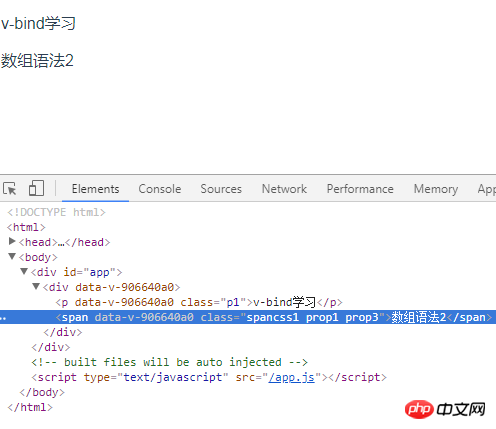 3.4 Binding inline styles
3.4 Binding inline styles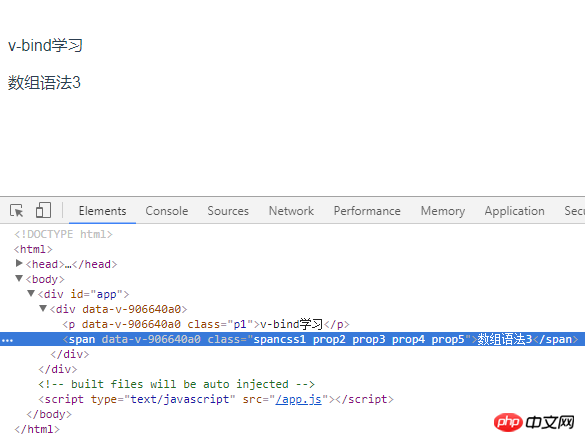 3.4.1 Object syntax, declare attributes in template, output corresponding attribute values in javascript, sample code As follows:
3.4.1 Object syntax, declare attributes in template, output corresponding attribute values in javascript, sample code As follows:
<template>
<div>
<p class="p1">{{title}}</p>
<span v-bind:style="{background:color1,fontSize:fontSize+'px'}" class="spancss1">{{text}}</span>
</div>
</template>
<script>
export default {
name: "v-bindLearn",
data() {
return {
title: "v-bind学习",
color1: 'green',
fontSize: 25,
text: "绑定内联样式1"
}
}
}
</script>
<style scoped>
.p1{
text-align: left;
}
.spancss1{
float: left;
}
</style>
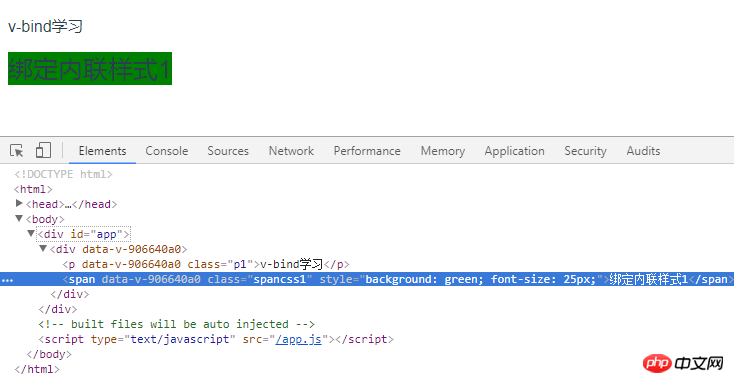 3.4.2 Array syntax, multiple style objects can be applied to the same element
3.4.2 Array syntax, multiple style objects can be applied to the same element<template>
<div>
<p class="p1">{{title}}</p>
<span v-bind:style="[prop1,prop2]" class="spancss1">{{text}}</span>
</div>
</template>
<script>
export default {
name: "v-bindLearn",
data() {
return {
title: "v-bind学习",
prop1: {
background:'green'
},
prop2: {
fontSize: '25px',
fontWeight: 'bolder'
},
text: "绑定内联样式1"
}
}
}
</script>
<style scoped>
.p1{
text-align: left;
}
.spancss1{
float: left;
}
</style>
<template>
<div>
<p class="p1">{{title}}</p>
<span v-bind:style="[prop1,prop2]" class="spancss1">{{text}}</span>
</div>
</template>
<script>
export default {
name: "v-bindLearn",
data() {
return {
title: "v-bind学习",
prop1: {
background:'green'
},
prop2: {
fontSize: '25px',
transform: 'rotate(7deg)'
},
text: "绑定内联样式1"
}
}
}
</script>
<style scoped>
.p1{
text-align: left;
}
.spancss1{
float: left;
}
</style>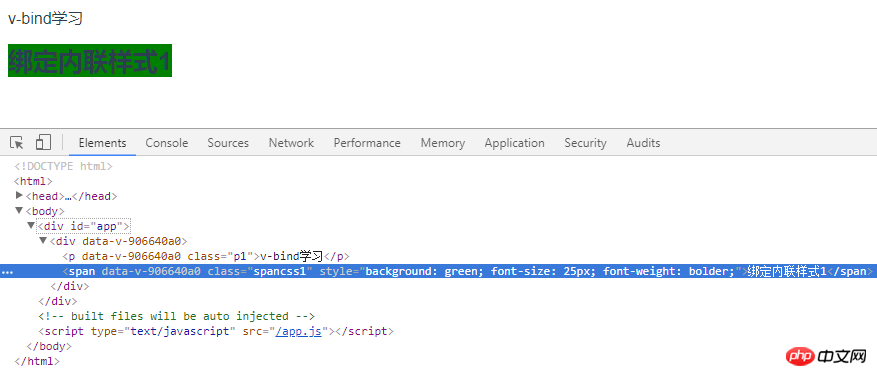 3.4.4 Multiple value binding, starting from 2.3.0 you can provide an array containing multiple values for the attribute in style binding, which is often used to provide Multiple prefixed values, if the browser supports flexbox without browser prefix, then only display: flex
3.4.4 Multiple value binding, starting from 2.3.0 you can provide an array containing multiple values for the attribute in style binding, which is often used to provide Multiple prefixed values, if the browser supports flexbox without browser prefix, then only display: flex<template>
<div>
<p class="p1">{{title}}</p>
<span v-bind:style="{ display: ['-webkit-box', '-ms-flexbox', 'flex'] }" class="spancss1">{{text}}</span>
</div>
</template>
<script>
export default {
name: "v-bindLearn",
data() {
return {
title: "v-bind学习",
text: "绑定内联样式4"
}
}
}
</script>
<style scoped>
.p1{
text-align: left;
}
.spancss1{
float: left;
}
</style>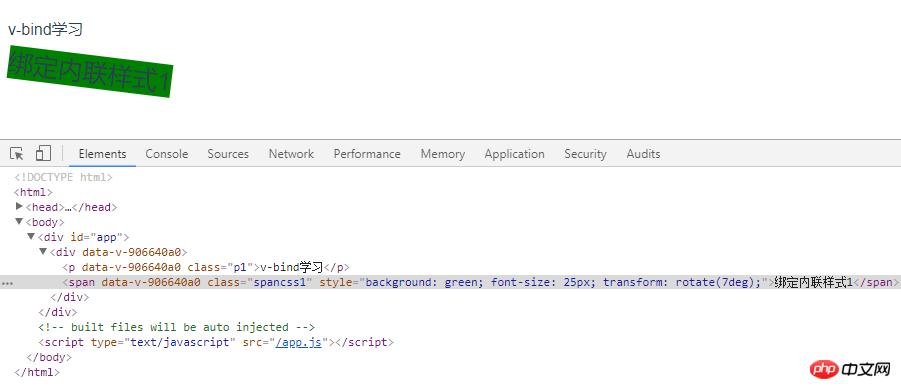
Summary: v-bind dynamically binds one or more features, or a component prop to an expression, which can easily render DOM
Related recommendations:
The initial construction process of the project in Vue (picture and text)
Analysis of the directory structure after Vue-cli builds the project (picture and text)
The above is the detailed content of Analysis of the 4-v-bind instruction (with code). For more information, please follow other related articles on the PHP Chinese website!

Hot AI Tools

Undresser.AI Undress
AI-powered app for creating realistic nude photos

AI Clothes Remover
Online AI tool for removing clothes from photos.

Undress AI Tool
Undress images for free

Clothoff.io
AI clothes remover

Video Face Swap
Swap faces in any video effortlessly with our completely free AI face swap tool!

Hot Article

Hot Tools

Notepad++7.3.1
Easy-to-use and free code editor

SublimeText3 Chinese version
Chinese version, very easy to use

Zend Studio 13.0.1
Powerful PHP integrated development environment

Dreamweaver CS6
Visual web development tools

SublimeText3 Mac version
God-level code editing software (SublimeText3)

Hot Topics
 1677
1677
 14
14
 1431
1431
 52
52
 1334
1334
 25
25
 1279
1279
 29
29
 1257
1257
 24
24
 Python vs. JavaScript: The Learning Curve and Ease of Use
Apr 16, 2025 am 12:12 AM
Python vs. JavaScript: The Learning Curve and Ease of Use
Apr 16, 2025 am 12:12 AM
Python is more suitable for beginners, with a smooth learning curve and concise syntax; JavaScript is suitable for front-end development, with a steep learning curve and flexible syntax. 1. Python syntax is intuitive and suitable for data science and back-end development. 2. JavaScript is flexible and widely used in front-end and server-side programming.
 JavaScript and the Web: Core Functionality and Use Cases
Apr 18, 2025 am 12:19 AM
JavaScript and the Web: Core Functionality and Use Cases
Apr 18, 2025 am 12:19 AM
The main uses of JavaScript in web development include client interaction, form verification and asynchronous communication. 1) Dynamic content update and user interaction through DOM operations; 2) Client verification is carried out before the user submits data to improve the user experience; 3) Refreshless communication with the server is achieved through AJAX technology.
 JavaScript in Action: Real-World Examples and Projects
Apr 19, 2025 am 12:13 AM
JavaScript in Action: Real-World Examples and Projects
Apr 19, 2025 am 12:13 AM
JavaScript's application in the real world includes front-end and back-end development. 1) Display front-end applications by building a TODO list application, involving DOM operations and event processing. 2) Build RESTfulAPI through Node.js and Express to demonstrate back-end applications.
 Understanding the JavaScript Engine: Implementation Details
Apr 17, 2025 am 12:05 AM
Understanding the JavaScript Engine: Implementation Details
Apr 17, 2025 am 12:05 AM
Understanding how JavaScript engine works internally is important to developers because it helps write more efficient code and understand performance bottlenecks and optimization strategies. 1) The engine's workflow includes three stages: parsing, compiling and execution; 2) During the execution process, the engine will perform dynamic optimization, such as inline cache and hidden classes; 3) Best practices include avoiding global variables, optimizing loops, using const and lets, and avoiding excessive use of closures.
 Python vs. JavaScript: Development Environments and Tools
Apr 26, 2025 am 12:09 AM
Python vs. JavaScript: Development Environments and Tools
Apr 26, 2025 am 12:09 AM
Both Python and JavaScript's choices in development environments are important. 1) Python's development environment includes PyCharm, JupyterNotebook and Anaconda, which are suitable for data science and rapid prototyping. 2) The development environment of JavaScript includes Node.js, VSCode and Webpack, which are suitable for front-end and back-end development. Choosing the right tools according to project needs can improve development efficiency and project success rate.
 The Role of C/C in JavaScript Interpreters and Compilers
Apr 20, 2025 am 12:01 AM
The Role of C/C in JavaScript Interpreters and Compilers
Apr 20, 2025 am 12:01 AM
C and C play a vital role in the JavaScript engine, mainly used to implement interpreters and JIT compilers. 1) C is used to parse JavaScript source code and generate an abstract syntax tree. 2) C is responsible for generating and executing bytecode. 3) C implements the JIT compiler, optimizes and compiles hot-spot code at runtime, and significantly improves the execution efficiency of JavaScript.
 From Websites to Apps: The Diverse Applications of JavaScript
Apr 22, 2025 am 12:02 AM
From Websites to Apps: The Diverse Applications of JavaScript
Apr 22, 2025 am 12:02 AM
JavaScript is widely used in websites, mobile applications, desktop applications and server-side programming. 1) In website development, JavaScript operates DOM together with HTML and CSS to achieve dynamic effects and supports frameworks such as jQuery and React. 2) Through ReactNative and Ionic, JavaScript is used to develop cross-platform mobile applications. 3) The Electron framework enables JavaScript to build desktop applications. 4) Node.js allows JavaScript to run on the server side and supports high concurrent requests.
 Python vs. JavaScript: Use Cases and Applications Compared
Apr 21, 2025 am 12:01 AM
Python vs. JavaScript: Use Cases and Applications Compared
Apr 21, 2025 am 12:01 AM
Python is more suitable for data science and automation, while JavaScript is more suitable for front-end and full-stack development. 1. Python performs well in data science and machine learning, using libraries such as NumPy and Pandas for data processing and modeling. 2. Python is concise and efficient in automation and scripting. 3. JavaScript is indispensable in front-end development and is used to build dynamic web pages and single-page applications. 4. JavaScript plays a role in back-end development through Node.js and supports full-stack development.




